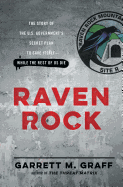
In Raven Rock, Garrett Graff (The Threat Matrix) has written a thorough analysis and history of disaster contingency plans, from the end of World War II into the Obama administration. He describes how the world entered a new era of warfare when the United States dropped atomic bombs on Japan in 1945, which unleashed fear for the safety of government personnel. Suddenly the threat of a nuclear war became all too real, and President Truman set into motion contingency plans for the continuation of American democracy in the event of such a disaster. These plans have morphed and changed over the past seven decades, but the core idea behind them remains the same: if under attack, have safe places well stocked with provisions and up-to-date communications systems, so the highest people in government can be protected and continue to work--while the masses of citizens fend for themselves.
Graff discusses the complexity of the presidential order of succession, the logistics of finding caves large enough to house personnel, the costs involved in building and stocking these massive underground bunkers with sufficient supplies, and the difficulty of maintaining them as deterioration sets in. Throughout, he consistently points out that the average citizen is not allowed into these protected zones, as well as the numerous executive orders (some written during the Cold War) that would go into effect, giving the administration extreme power. Graff's words leave a chill as he depicts just how insignificant most of the population is in the eyes of the government. --Lee E. Cart, freelance writer and book reviewer

